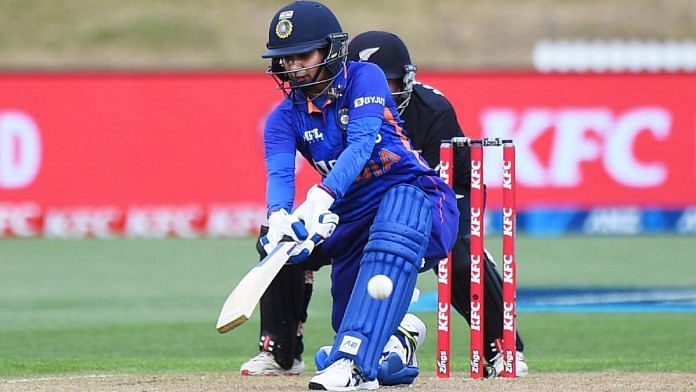New Delhi: Four years and seven months since Anya Shrubsole dislodged Rajeshwari Gayakwad’s off stump and sent the 24,000-strong Lord’s crowd into raptures, the ICC Women’s World Cup returns Friday morning India time, with New Zealand as hosts and England as the defending champions.
India have had a good record in ICC tournaments in the past few years — finishing as runners-up in the aforementioned 2017 World Cup as well as the 2020 Women’s T20 World Cup — but no major trophies in the women’s game.
This time, the Mithali Raj-led side is looking to go one step better, but despite strides made in the past 12 months and consistent game time, several obstacles, including lacunae in quality and form, stand in the way of the Women in Blue.
The World Cup begins at Mount Maungunui’s picturesque Bay Oval, with hosts New Zealand taking on the West Indies, while India will wait till Sunday to face archrivals Pakistan at the same venue.
All eight participating teams will play each other once in a round-robin format, with the top four qualifying for the semi-finals, which will be held in Wellington and Christchurch. Christchurch will also host the final on 3 April.
Also read: Women’s World Cup: Kohli, Rohit cheer for Team India ahead of clash with Pakistan
Avoiding rustiness
One of the biggest barriers for international cricket teams touring New Zealand since the start of the Covid-19 pandemic has been the managed isolation and quarantine (MIQ) policy.
Put in place by the Jacinda Ardern government to undercut any potential overload on New Zealand’s healthcare system, MIQ has required travellers from abroad to undergo strict self-isolation and quarantine at designated facilities.
MIQ has not only meant that six teams have had to wait for an extended period before commencing any training or practice games ahead of the World Cup, but South Africa batter and 2021 ICC Women’s ODI Cricketer of the Year Lizelle Lee has also been forced to sit out of her side’s opening encounter against Bangladesh due to her delayed arrival in the country.
India, meanwhile, countered this issue by arriving in New Zealand a few weeks earlier to play five ODIs and a T20 against the White Ferns, as the hosting team is nicknamed.
Despite losing the T20 match as well as the ODI series against New Zealand 4-1, India gained numerous opportunities to hand out debuts, test their bench strength, and assess tactical weaknesses prior to the big event.
Several squad members had also spent a significant amount of time in Australia in late 2021, playing in that country’s women’s T20 league, the Big Bash.
Trans-Tasman threats and competing for best of the rest
As competitive as India’s bilateral ODI performances have been in the past few months, the series defeats away to Australia and New Zealand ultimately reflected some wide chasms in quality and form.
All series were marked by failures to restrict the opposition to totals below 250, as well as subpar strike rates from specialist batters.
For instance, since the start of September 2021, no Indian bowler save evergreen veteran Jhulan Goswami has been able to either maintain an average below 30 or an economy rate under five.
Similarly, although Mithali Raj, wicketkeeper Richa Ghosh and opener Smriti Mandhana all averaged above 40 with the bat in the same timeframe, Ghosh and reserve/stand-by player Sabbhineni Meghana are the only ones to strike at over a run-a-ball, with Mandhana coming in third at 88.
In contrast, both New Zealand and Australia boast multiple options who performed either one such role or exhibited all-round abilities consistently in this timeframe. In-form players in the two sides include Beth Mooney, Ashleigh Gardner, and Tahlia McGrath for Australia, and Sophie Devine, Amelia Kerr, and Hannah Rowe for New Zealand.
The Australians stand as clear tournament favourites, having earned the “Invincibles” tag after completing a historic 26-match win streak last year, which was ended by India. Between the 2017 and 2022 Women’s World Cups, Australia have only suffered two defeats in competitive ODIs, and one loss in a warm-up match to New Zealand.
As a result, India may realistically need to compete with England and South Africa for a place in the semi-finals. With just four wins from 16 ODIs since the start of 2021 in contrast to England’s eight from 14 and South Africa’s 13 from 17, the numbers are stacked against India.
In order to overcome this patchy record and reach a second consecutive ODI World Cup final, Mithali Raj’s side will need to take encouragement from their two-run win over South Africa in the warm-up game on 27 February, and England’s poor performances in the Women’s Ashes tour concluded last month.
(Edited by Rohan Manoj)
Also read: BCCI can close the wage gap in women’s cricket. Just look at tennis and USwomen soccer



